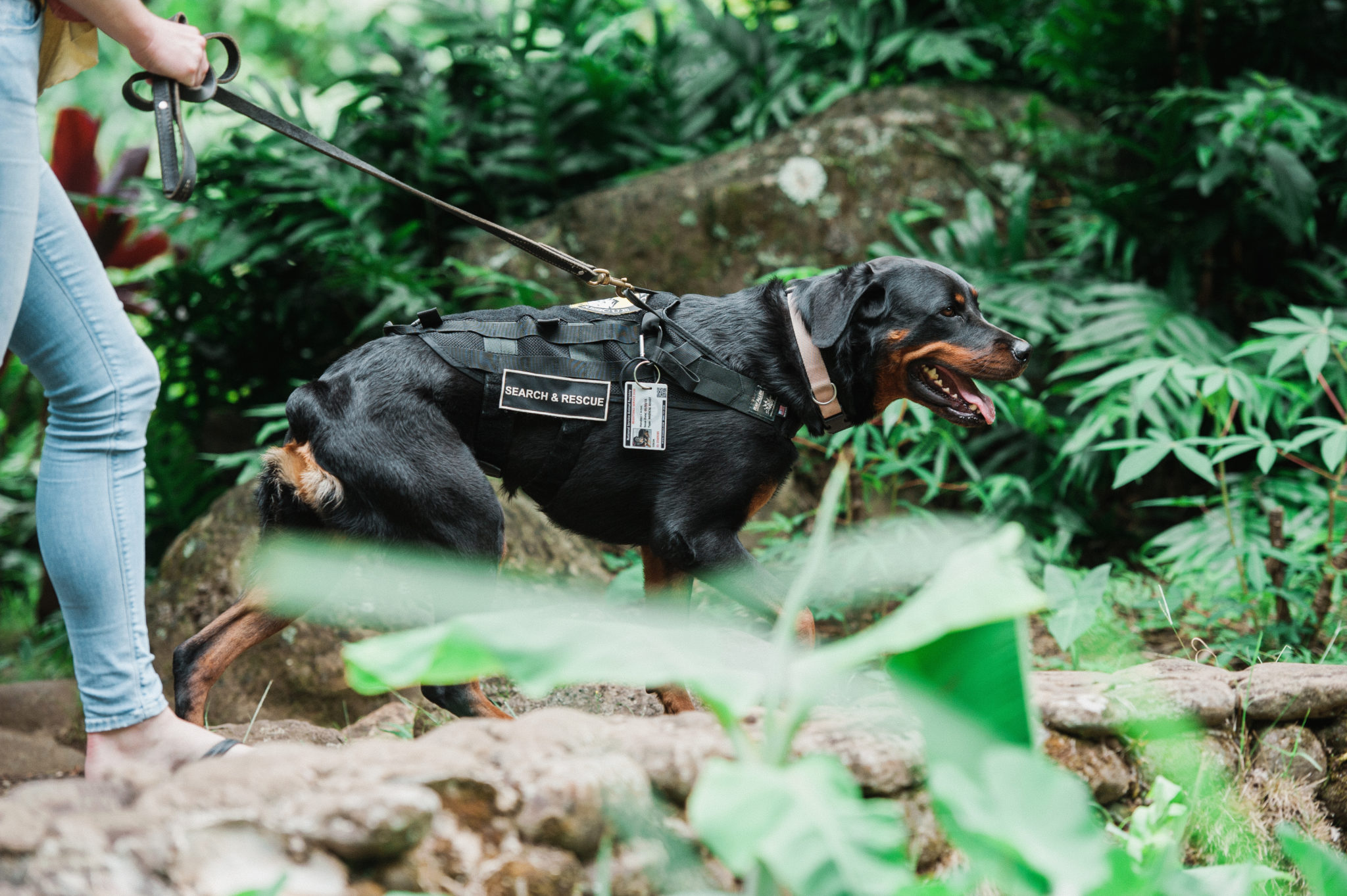Images by John Hook
Jennifer Kushi has a Celtic infinity knot tattoo that runs from her ankle to her hip, where it meets a tattoo of yellow rays shining over a turbulent black ocean. This emblem matches that of an embroidered patch on the black harness of her dog Cocoa, a sweet 2-year-old Rottweiler. It is the logo of Maui Search and Rescue, for which Cocoa is one of two dogs trained to detect human remains.
Cocoa, who has the typical brown markings and docked tail of her breed, is both Kushi’s pet and her partner in searches for missing persons. The two are practically inseparable, aside from the hours Kushi works as a nurse in obstetrics and gynecology or urgent care for Maui Medical Group. At night, Cocoa sleeps in a kennel, its door open, in Kushi’s room. Her four children, ages 2, 5, 6, and 8, adore the dog. “She is actually one of the biggest babies in the family,” Kushi says. In her spare time, Kushi may take Cocoa to Polipoli State Recreation Area, a cool forested space where the pair train for searches, or to meetings with Maui Search and Rescue, of which the 36-year-old is vice president. This all-volunteer organization consists of 50 to 80 members, with 15 to 20 who actively participate, as well as a handful of search and rescue dogs.

“I’ve always wanted a Rottweiler because of their temperaments,” says Kushi, who got Cocoa in February 2013 when she was roughly 2 months old. “I know that they’re smart.” Cocoa was the runt of the litter, picked on by her siblings but eager for love and attention. In the dog training classes that Kushi sent her to that summer, Cocoa learned common tasks such as heeling, as well as the less common one of picking up scents. Cocoa was a natural.
In February 2014, Kushi was watching the news when she learned that a loosely formed group (which would eventually become Maui Search and Rescue) was searching for missing pregnant woman Carly “Charli” Scott, and was recruiting volunteers with medical experience. Kushi decided to pitch in. After witnessing the despair and exhaustion of friends and family heading the search, she recalled the stories a former Maui pathologist she had worked with told her regarding FEMA-certified dogs that had been brought from the mainland to assist in searches. What they needed, she realized, was such a dog, which could cover as much ground as 50 human searchers.
Cocoa was a good fit for that type of task—desired traits include scenting capability, intelligence, a strong play drive, and physical stamina—so, after researching proper training procedures extensively online, Kushi began training her as a cadaver dog, which detects and tracks the scent of decaying human remains. (Maui Search and Rescue also utilizes an air-scent dog, which has a brief window of time to detect the scent of a live person.) They train in rural locations, where Kushi hides vertebrae and placentas in various states of decay for Cocoa to detect and locate. The Rottweiler has developed her own way to signify when she has found something, tapping the spot before she sits beside it. She has also been trained to scent human blood, so that she can help find injured persons.

On July 4, 2015, Kushi, Cocoa, Maui Search and Rescue president Adam Gaines, and air-scent dog Mia boarded a plane for O‘ahu to aid in the search for Justin Clark, a hiker who had been missing for nearly four days, after being contacted by his family. Despite it being the Rottweiler’s first ever flight, the large dog calmly settled under the seats in front of Kushi, not minding the fidgety toddler above her head or the crying baby nearby. By the time they landed, firefighters had found Clark, so Kushi and Gaines took the opportunity to bring the department pizzas instead—one of the organization’s priorities is to create better relationships with such agencies, so that they will recommend that families contact Maui Search and Rescue as soon as they think someone is missing. “We want the call within one or two hours, especially with an air-scent dog,” Kushi says. “The longer you wait, the more the scent grows cold.”
Maui Search and Rescue has participated in approximately 14 searches on Maui, O‘ahu, and Big Island, six of which have resulted in relevant finds. To further expand their capabilities and credibility, the organization’s canine-handler teams are headed to California in April to undergo FEMA certification, which will teach and test them on search and rescue tactics and skills to utilize after disasters. Then, they’ll learn to descend cliff faces with Maui Rappel to further expand their range of search.
Since Clark’s rescue, Kushi and Cocoa have returned to O‘ahu several times to continue searching for 16-year-old Noah Montemayor, who vanished from his Hawai‘i Kai home, and 17-year-old Daylenn “Moke” Pua, who went missing while hiking the treacherous Stairway to Heaven trail. Neither has been found, but Maui Search and Rescue continues to stay in touch with the families.
Of her own children, Kushi says, “They know what [Cocoa] does, that she’s not necessarily looking for somebody that’s alive. … They understand that everybody does need to come home.”
This story is part of our Companions Issue.

